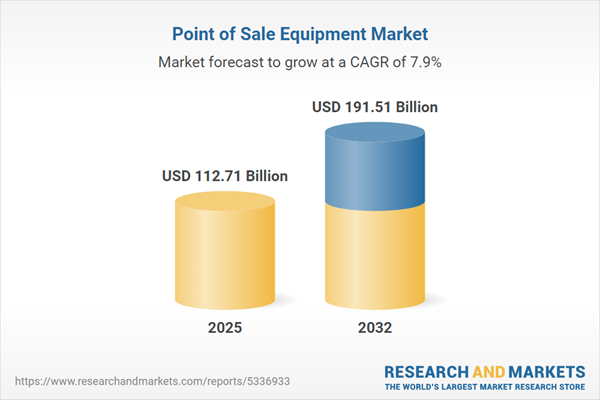Speak directly to the analyst to clarify any post sales queries you may have.
The point of sale equipment market is undergoing rapid transformation fueled by technology-driven innovation, changing consumer preferences, and evolving merchant demands. Senior executives must anticipate these shifts to position their businesses for continued relevance and strong returns.
Point of Sale Equipment Market Snapshot
Recent research indicates the global point of sale equipment market grew from USD 104.38 billion in 2024 to USD 112.71 billion in 2025. This sector is projected to continue its expansion at a CAGR of 7.88%, reaching USD 191.51 billion by 2032. Growth is propelled by accelerated adoption of digital payment systems, the shift towards unified commerce platforms, and increasing demand for secure, integrated solutions. Mature and emerging markets alike demonstrate robust interest, underpinned by regulatory pressures and consumer expectations for seamless payment experiences.
Scope & Segmentation in Point of Sale Equipment
- Offering: Hardware, Services, Software
- Connectivity Type: Wired Connectivity, Wireless Connectivity
- Distribution Channel: Offline, Online
- End-User: Education, Entertainment & Leisure, Healthcare, Hospitality, Manufacturing, Retail, Transportation
- Region: Americas (North America: United States, Canada, Mexico; Latin America: Brazil, Argentina, Chile, Colombia, Peru); Europe, Middle East, & Africa (Europe: United Kingdom, Germany, France, Russia, Italy, Spain, Netherlands, Sweden, Poland, Switzerland; Middle East: United Arab Emirates, Saudi Arabia, Qatar, Turkey, Israel; Africa: South Africa, Nigeria, Egypt, Kenya); Asia-Pacific (China, India, Japan, Australia, South Korea, Indonesia, Thailand, Malaysia, Singapore, Taiwan)
- Company Coverage: Verifone Systems, Worldline SA, PAX Technology Limited, Newland Payment Technology, NCR Corporation, Fujitsu Limited, Toshiba TEC Corporation, Diebold Nixdorf, Zebra Technologies Corporation, Seiko Epson Corporation
- Technologies: Cloud-native POS, mobile applications, IoT connectivity, machine learning, edge computing, biometric authentication, voice-enabled payment interfaces
Key Takeaways for Senior Decision-Makers
- Growing demands for flexible and integrated point of sale solutions are reshaping investment strategies across retail, hospitality, and allied sectors.
- Legacy hardware providers are expanding software-as-a-service portfolios to deliver analytics, CRM, and predictive features that meet evolving merchant requirements.
- Emerging operational models emphasize subscription-based services, enabling recurring revenue streams and stronger end-customer engagement.
- Omnichannel approaches now drive deployment of unified commerce solutions, fostering real-time inventory integration and consistency across in-store and digital transactions.
- User experience innovation—including loyalty integration, contextualized promotions, and frictionless checkout—continues to differentiate leading platforms.
- Collaborative go-to-market strategies between manufacturers, fintechs, and communications providers enable bundled and scalable end-to-end solutions.
Tariff Impact and Supply Chain Response
Recent tariff introductions on imported components have placed pressure on hardware cost structures, compelling procurement leaders to diversify supplier regions, explore nearshoring, and invest in domestic assembly lines. Dynamic sourcing strategies, combined with expansion into software and subscription services, support margin protection and operational resilience. Vendor agility in adapting supply chains and manufacturing locations is now a critical focal point.
Methodology & Data Sources
The study applies a hybrid methodology, incorporating primary interviews with executives in point of sale equipment production, service, and deployment. Secondary research includes review of industry publications, regulatory filings, and patent databases. All quantifiable data points are validated using multiple sources and competitive benchmarking frameworks.
Why This Report Matters
- Detailed segmentation and technology analysis equip business leaders to formulate targeted product strategies and prioritize R&D investments.
- Insights into regional dynamics and supply chain adaptation support market entry, expansion, and procurement decision-making for multi-national organizations.
Conclusion
The point of sale equipment market is defined by ongoing innovation, complex value chains, and the imperative for tailored, future-ready solutions. Effective strategy development hinges on understanding these cross-cutting trends and aligning capabilities with industry shifts.
Additional Product Information:
- Purchase of this report includes 1 year online access with quarterly updates.
- This report can be updated on request. Please contact our Customer Experience team using the Ask a Question widget on our website.
Table of Contents
3. Executive Summary
4. Market Overview
7. Cumulative Impact of Artificial Intelligence 2025
Companies Mentioned
The companies profiled in this Point of Sale Equipment market report include:- Verifone Systems, Inc.
- Worldline SA
- PAX Technology Limited
- Newland Payment Technology Co., Ltd.
- NCR Corporation
- Fujitsu Limited
- Toshiba TEC Corporation
- Diebold Nixdorf, Incorporated
- Zebra Technologies Corporation
- Seiko Epson Corporation
Table Information
| Report Attribute | Details |
|---|---|
| No. of Pages | 184 |
| Published | October 2025 |
| Forecast Period | 2025 - 2032 |
| Estimated Market Value ( USD | $ 112.71 Billion |
| Forecasted Market Value ( USD | $ 191.51 Billion |
| Compound Annual Growth Rate | 7.8% |
| Regions Covered | Global |
| No. of Companies Mentioned | 11 |









